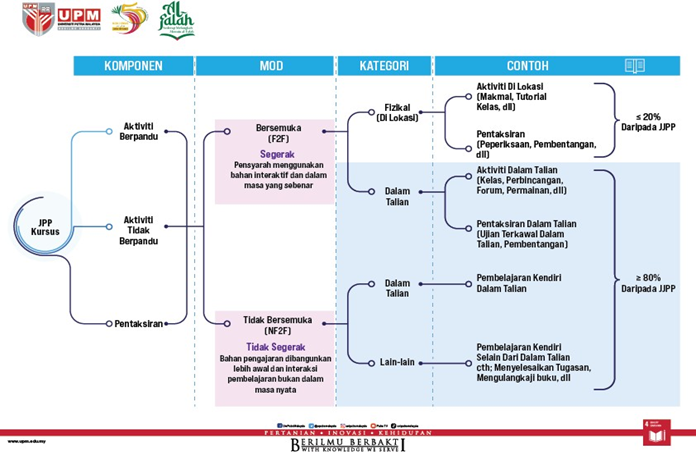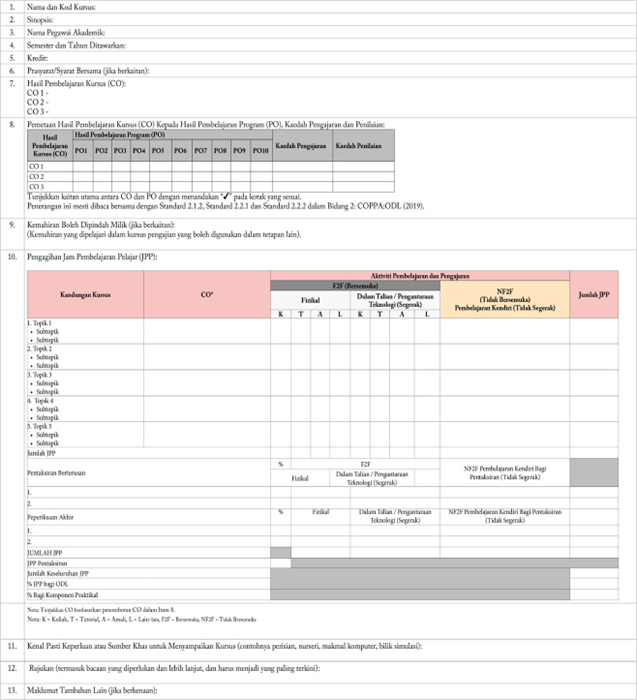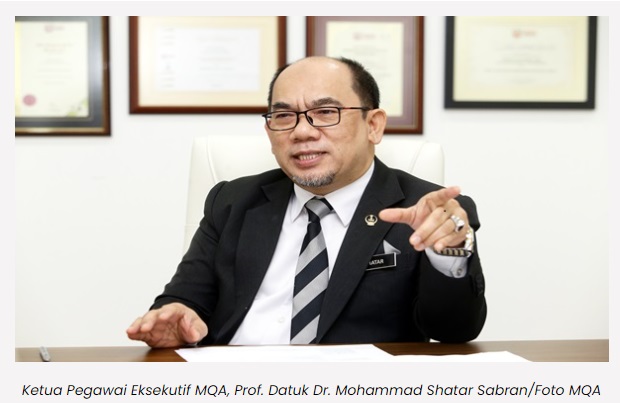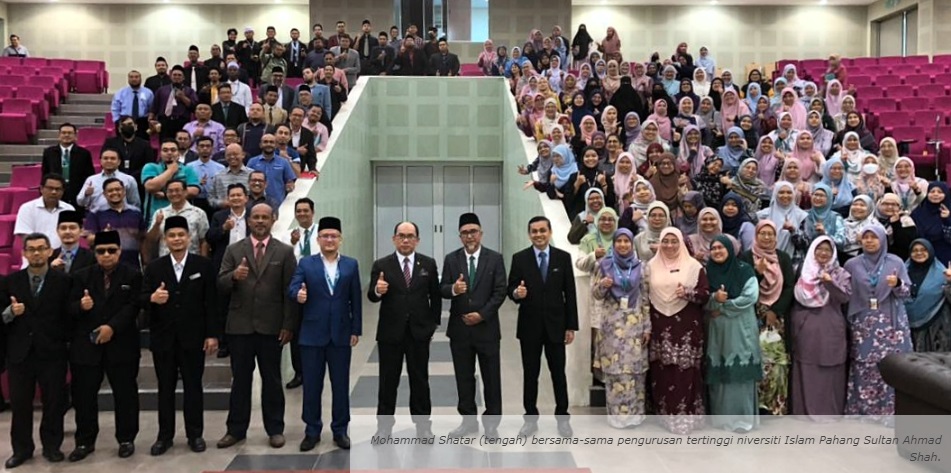|
This section explains in general about the development of Student Learning Hours (JPP) and Self-Instructional Materials (SIM) for UPM's ODL program based on the COPPA:ODL (2019) standard. Compliance with the JPP and SIM guidelines by programme owners is very important in ensuring compliance with the COPPA:ODL (2019) standard.
4.1 JPP ODL DEVELOPMENT GUIDE
4.1.1 ODL Programme Criteria
- An example of compliance with the mandatory criteria for the undergraduate ODL programme is as in Table 4.1 below:
Table 4.1 Example of Compliance with Mandatory Criteria COPPA:ODL (2019) Undergraduate ODL Programme
| |
PROGRAMME WITH 40 COURSES (120 CREDIT) |
| |
Course 1 |
Course 2 |
Course 3 |
……………………… |
Course 4 |
| |
3 credit |
|
|
|
|
| |
JPP (120 hours)
|
• A total of 80% of JPP is delivered as ODL = 96 hours.
• While the remaining 20% ​​can be conducted face-to-face = 24 hours.
• If a course is delivered on an ODL basis that is 80% of the JPP, then the course in question may be considered
an ODL course.
|
| |
• A total of 60% of the entire course in the programme, i.e. 40 courses are delivered in ODL = 24 ODL courses.
• While the remaining 40% of the entire course in the programme which is 40 courses can be conducted conventionally = 16
conventional courses.
• If there are 24 or more courses conducted as ODL, then the programme can be counted as an ODL programme.
|
2. A course is categorized as an ODL course based on the following criteria:
a.At least 80% of the JPP must be implemented:
i. synchronous ie delivered online or through the use of technology (online/technology mediated); and
ii. asynchronous, which is delivered through independent learning.
b. Supported through regular and effective interaction between students and lecturers with the provision of SIM and other learning support services that can be
achieved through the LMS.
c. The implementation of PdP with the physical face-to-face method must not exceed 20% of the total JPP for a course
3.Examples of ODL course activities are as illustrated in Figure 4.1 below:

Figure 4.1: Components, Modes and Categories for Teaching and Learning Activities in an ODL Course
4.1.2 Development Guideline on JPP ODL Courses
1. JPP is the expected amount of time that students will spend on the entire PdP activity, including assessment to achieve the learning outcomes of the ODL course set.
2. The JPP calculation needs to take into account all PdP activities of a course whether formal or informal, guided or unguided (non-guided/independent learning),
as well as including assessment.
3. JPP for a course consists of:
i. Guided learning hours either face-to-face (guided F2F) or/and non-face-to-face (guided NF2F);
ii.Independent learning hours (non-guided/independent learning NF2F) such as assessment preparation, review, assignments, projects); as well as
iii.Continuous assessment hours and exams
4. Examples of activities for guided learning (guided) and non-guided/independent learning (non-guided/independent learning) are as in the following Table 4.2:
Table 4.2 Examples of Activities for Guided/Guided and Non-Guided/Independent Learning (Non-Guided/Independent Learning)
| |
Category |
Guided Learning |
Non-Guided/Independent Learning (Non-Guided/Independent Learning) |
| |
Activity |
• Interact with lecturers and other students
synchronously (at the same time).
• Reading or using teaching materials.
• Participation in discussions, assignments and
presentations.
|
• Interact with the lecturer and other students asynchronously (at different
times).
• Review the teaching material that has been presented in the lecture session.
• Lecture preparation.
• Give respond and engage in discussions through forums, social sites or
webinars.
• Complete assignments and presentations.
|
5. JPP is supported through synchronous or non-synchronous activities
6. The implementation of the ODL course must involve at least one (1) face-to-face meeting session either physically or online. Examples of activities
that can be implemented in this session are group discussions and lectures.
7. JPP information must be filled in Table 4 In order to simplify the calculation of JPP, Table 4 in COPPA:ODL (2019) is used as a template
(https://bit.ly/Table4ODL). The information written in the Table needs to be copied into the relevant Table 4.3.
Jadual 4.3 Summary of Course Information

8. Synchronous learning refers to PdP sessions where lecturers and students gather at the same time (physical or virtual), and interact at the same time (but not
necessarily at the same location) online or using technology mediated ) such as web conferencing applications and
9. Asynchronous learning is independent learning done at different locations and/or times. The lecturer sets a period for students to read or study teaching materials
such as lectures, recorded videos, audio lectures, interactive slides, lecture notes and any recommended learning materials (for example websites, chapters in books,
compilations from videos and so on). Learning takes place through online activities such as interactive discussions using forums and gamification as part of
formative assessment.
10. The calculation of the amount of JPP needs to take into account the unique requirements or conditions of a discipline/course.
11. The proposed allocation of self-study hours based on face-to-face meeting hours for various PdP and assessment activities is as in following Table 4.4 :
Jadual 4.4 : Estimate Guide* JPP Allocation For Various PdP Activities and Assessment
| |
Activity |
Guided Learning Hours |
Self Study Hours |
| |
Learning |
|
|
| |
• Direct interaction with students using the Zoom,
Google Meet and Webex applications in
lectures/tutorials/conversations/demonstrations and
so on.
|
1 hour (F2F) |
1-2 hour (Depending if the topic is difficult it may be up to 3 hour) |
| |
• Collaborative learning activities include group work or
discussion between groups based on the topic given by
the lecturer/PBL/forum.
|
1 hour (NF2F) |
1-2 hour |
| |
• View the uploaded material on the screen. |
On average is 5 minutes per screen (NF2F).
Example:
18 slaid x 5 minute =90 minute or 1.5 hour
|
Can be determined by the lecturer by looking at level of difficulties of the journal article |
| |
• Teaching activities include assignments such as group
discussions, online forums and online collaborative interactions.
|
1 hour (NF2F) |
1-2 hour |
| |
• Presentation session (recording) |
30 minute (NF2F) |
3-4 hour |
| |
• Case summary |
0 hour |
8-11 hour per day throughout semester or 40-50 hour per week or 120 minute per page (Choose the appropriate one) |
| |
Assessment |
|
|
| |
Final Examiation Open Book Exam/Take Home Exam |
3 hour (NF2F) |
9 hour |
| |
Problem Based Learning |
2 hour (F2F) |
3 hour |
| |
Presentation/Viva |
1 hour (F2F) |
3-4 hour |
| |
Report/Essay (2000 perkataan) |
0 hour |
10 hour |
| |
Quiz/Test |
1 hour (NF2F) |
1-2 hour |
| |
Project Based Learning |
0 hour |
Idea/Preparation= 5 hour product = 20 hour |
| |
Lab Assignments/ Exercises/ Tutorials |
1 hour (F2F) |
1-2 hour |
*Note: Guide to making JPP estimation:
The number of hours suggested is only a guide.
For module learning with a set time or e-learning method, if 3 hours are set then it is considered independent learning.
|































